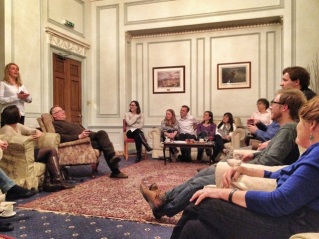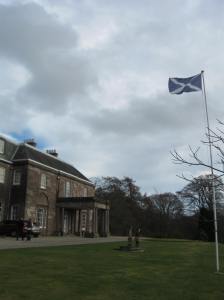ISHR Reading Weekend 2014, The Burn, 21-23 March
April 2, 2014 Leave a comment
Dawn Jackson Williams, School of History communications intern and associate of the ISHR, attended the annual ISHR Reading Weekend. Below is her account.
The weekend of the 21–23 March saw members and guests of the Institute of Scottish Historical Research head to the Burn, just south of the Cairngorms National Park, where they enjoyed three days encompassing a variety of presentations, historical discussions, and a field trip to learn about Pictish stones.
Following a mid-afternoon arrival on the Friday the group was given plenty of time to get acquainted over tea in the Burn’s beautiful Drawing Room. After dinner, the MLitt students in attendance kicked off the weekend’s presentations with a ‘Three Minute Thesis’ session. The six gave brief introductions to their areas of research, which ranged from an exploration of the queenship of Margaret Tudor to a study of Scottish music halls in the early twentieth century. The postgraduate focus of the evening continued in a more light-hearted vein as Claire Hawes demonstrated herself to be not only a talented historian, but also a brilliant musician; she treated us to a musical exposition of the highs and lows of PhD life, set to the tune of ABBA’s ‘The Winner Takes It All’.
The next morning saw two fascinating panels, featuring PhD students Sean Murphy, Carol Bailey, Liz Hanna, and Claire Hawes, which covered a range of topics including ‘verbal tartanry’ and its role in Scottish diasporic culture, the language debates of the eighteenth and nineteenth centuries, James IV and his uses of chivalry, and the nature of fifteenth-century urban communities. After lunch the group ventured to Pictavia, a nearby attraction boasting a collection of Pictish stones, where they enjoyed the commentary of an extremely knowledgeable guide, and – perhaps less cerebrally – the interactive nature of the exhibit which encouraged visitors to run their hands over replica Pictish stones, and to play a reproduction Pictish harp. The ISHR was also pleased to discover a reference to the research of Dr Alex Woolf in pride of place on the wall beside one of the opening exhibits. The two articles of particular relevance to the displays at Pictavia can be found here: ‘Dún Nechtáin, Fortriu and the Geography of the Picts’, and ‘Pictish matriliny reconsidered’.

Hearing about the MLitt research topics in the Drawing Room of the Burn. (Photo credit Darren S. Layne).
On returning to the Burn the group reaped the benefits of a pre-dinner skills panel, with Matt McHaffie sharing his experience of finishing the PhD, and offering advice to those PhD students present to whom handing in still felt like a distant dream. Darren Layne gave a persuasive presentation regarding the virtues of Evernote and its potential benefits for historians. The schedule for the weekend (arranged by ISHR intern Amy Eberlin) had boasted ‘Prescribed Fun Time’ for the hour or so after dinner, and the inaugural ISHR pub quiz certainly provided both entertainment and some head-scratching. History as a potential category was deliberately avoided and the assembled staff and students were tested on their general knowledge, geography, and, in a picture round, their ability to recognise the logos of international organisations. The ‘Blue Owls’ helmed by ISHR Director Katie Stevenson won, although as they boasted a one-time St Andrews University Challenge team-member, this had been widely predicted. The team of ISHR’s Edinburgh guest, Steve Boardman, came joint last after forgetting that the Queen was Canada’s head of state.
The final day saw some erratic weather – bright sunshine interspersed with hail – but no change in the continuing high standard of presentations across the weekend. Piotr Potocki explored Catholic identity and the Catholic church in Scotland in the late nineteenth and early twentieth centuries, whilst Neil McGuigan took listeners on a journey to the ninth and tenth centuries with his account of the sons of Ivar and the medieval kingdom of Northumbria. The weekend was ably rounded off by Dr Steve Boardman, who gave a compelling paper on the depiction of Anglo-Welsh and Anglo-Irish relations as depicted in Scottish sources. After a final lunch, the group dispersed, perhaps a little more tired, but certainly more knowledgeable than they had been upon arrival.
